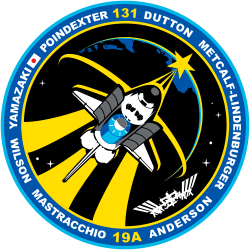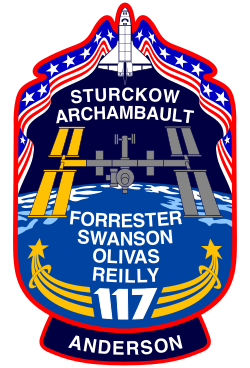Clayton Anderson
| Clayton Anderson | |
|---|---|
 | |
| Land: | USA |
| Organisation: | NASA |
| ausgewählt am | 5. Juni 1998 (17. NASA-Gruppe) |
| Einsätze: | 2 Raumflüge |
| Start des ersten Raumflugs: | 8. Juni 2007 |
| Landung des letzten Raumflugs: | 20. April 2010 |
| Zeit im Weltraum: | 166d 21h 11min |
| EVA-Einsätze: | 6 |
| EVA-Gesamtdauer: | 38h 28m |
| ausgeschieden am | Februar 2013 |
| Raumflüge | |
Clayton Conrad „Clay“ Anderson (* 23. Februar 1959 in Omaha, Nebraska, USA) ist ein ehemaliger US-amerikanischer Astronaut. Er absolvierte von Juni bis November 2007 einen Langzeitaufenthalt an Bord der Internationalen Raumstation (ISS). Er verließ die NASA im Februar 2013.[1]
Ausbildung
Clayton Anderson absolvierte die Ashland-Greenwood High School in Ashland, Nebraska im Jahre 1977. Am Hastings College erreichte er 1981 einen Bachelor-Abschluss in Physik, an der Iowa State University 1983 einen Master-Abschluss in Luft- und Raumfahrttechnik.
Raumfahrertätigkeit
Nach seinem Studium trat Anderson der NASA bei. Am Johnson Space Center in Houston wurde er Spezialist für Flugbahnen. An der Vorbereitung und Begleitung der Flüge STS-34 im Jahre 1989 und STS-31 1990 war er direkt beteiligt.
Anderson bewarb sich als Astronaut (NASA-Gruppe 16), kam am 21. Januar 1996 in die Endauswahl, wurde aber im ersten Anlauf dann doch abgelehnt. Sein zweiter Versuch war erfolgreich, und so wurde er am 5. Juni 1998 mit der 17. NASA-Gruppe der Öffentlichkeit als zukünftiger Astronaut vorgestellt. Bevor er einem Raumflug zugeteilt wurde, arbeitete er an einer Erweiterung des Sicherheitssystems des Shuttle-Cockpits, war 2001/2002 in der Support Crew der ISS-Expedition 4 und arbeitete als Capcom. Außerdem wurde er für Außenbordaktivitäten ausgebildet. Clayton Anderson ist Funkamateur mit dem Rufzeichen KD5PLA.[2]
NEEMO 5
Vom 16. bis 29. Juni 2003 war er Teilnehmer am NASA-Unterseelabor NEEMO 5. An Bord der Aquarius waren noch Ryan Snow, James Talacek, Emma Hwang sowie die NASA-Astronauten Peggy Whitson und Garrett Reisman. Alle drei Astronauten waren später als ISS-Dauergäste auf der ISS oder sind als solche eingeplant.
ISS-Expedition 15
Anderson war seit Dezember 2003 Flugingenieur in der Reservemannschaft (Double für Sunita Williams) der ISS-Expedition 14, die im September 2006 zur Internationalen Raumstation (ISS) startete. Anderson wurde danach im Januar 2005 als ISS-Flugingenieur für die ISS-Expedition 15 eingeteilt und startete am 8. Juni 2007 mit der Shuttle-Mission STS-117 zur Raumstation. Er arbeitete und lebte fünf Monate auf der ISS, bevor er mit STS-120 am 7. November 2007 wieder zurückkehrte.
STS-131
Am 5. Dezember 2008 wurde Anderson als Missionsspezialist für die Mission STS-131 benannt.[3] Der Start erfolgte am 5. April 2010, die Landung am 20. April 2010.[4] Zusammen mit Richard Mastracchio führte er drei Außenbordeinsätze durch.
Privates
Anderson ist verheiratet und hat zwei Kinder.
Siehe auch
Weblinks
- Kurzbiografie von Clayton Anderson bei spacefacts.de
- Biografie von Clayton Anderson in der Encyclopedia Astronautica (englisch)
- NASA-Biografie von Clayton Anderson (englisch; PDF)
Quellen
- ↑ NASA Astronaut Clayton C. Anderson Leaves Agency. NASA, 4. Februar 2013, abgerufen am 5. Februar 2013 (englisch).
- ↑ KD5PLA in der Datenbank der Federal Communications Commission (FCC)
- ↑ NASA Assigns Astronaut Crews for Future Space Shuttle Missions. NASA, 5. Dezember 2008, abgerufen am 7. Dezember 2008 (englisch).
- ↑ STS-131 Mission Information. NASA, 20. April 2010, abgerufen am 2. April 2010 (englisch).
| Personendaten | |
|---|---|
| NAME | Anderson, Clayton |
| ALTERNATIVNAMEN | Anderson, Clayton Conrad (vollständiger Name); Anderson, Clay |
| KURZBESCHREIBUNG | US-amerikanischer Astronaut |
| GEBURTSDATUM | 23. Februar 1959 |
| GEBURTSORT | Omaha, Nebraska, Vereinigte Staaten |
Auf dieser Seite verwendete Medien
This patch commemorates the sixteenth expeditionary mission to the International Space Station (ISS). The design represents the conjunction of two unique astronomical events: a transit of the ISS across the surface of a full moon, and a nearly complete annular eclipse of the sun. The ISS is shown in its complete configuration, symbolizing the role of this expedition in preparing for the arrival and commissioning of international partner modules and components. The ISS transit across the moon highlights its role in developing the techniques and innovations critical to enable long-duration expeditions to the lunar surface and beyond.
The STS-131/19A crew patch highlights the Space Shuttle in the Rendezvous Pitch Maneuver (RPM). This maneuver is heavily photographed by the International Space Station (ISS) astronauts, and the photos are analyzed back on earth to clear the Space Shuttle's thermal protection system for re-entry. The RPM illustrates the teamwork and safety process behind each Space Shuttle launch. In the Space Shuttle's cargo bay is the Multi-Purpose Logistics Module (MPLM), Leonardo, which is carrying several science racks, the last of the four crew quarters, and supplies for the ISS. Out of view and directly behind the MPLM, is the Ammonia Tank Assembly (ATA) that will be used to replace the current ATA. This will take place during three Extra Vehicular Activities (EVAs). The 51.6° Space Shuttle orbit is illustrated by the three gold bars of the astronaut symbol, and its elliptical wreath contains the orbit of the ISS. The star atop the astronaut symbol is the dawning sun, which is spreading its early light across the Earth. The background star field contains seven stars, one for each crewmember; they are proud to represent the United States and Japan during this mission.
NASA astronaut Clayton C. Anderson, mission specialist
The operational teamwork between human space flight controllers and the on-orbit crew take center stage in this emblem. Against a backdrop familiar to all flight controllers, past and present, independent of any nationality, the fifteenth expedition to the ISS is represented in Roman numeral form as part of the ground track traces emblazoned on the Mercator projection of the home planet Earth. The ISS, shown in its fully operational, assembly complete configuration, unfurls and then reunites the flags of this Russian and American crew in a show of our continuing international cooperation. Golden spheres placed strategically on the ground track near the flight control centers of the United States and Russia serve to symbolize both the joint efforts from each nation's team of flight controllers and the shuttle and Soyuz crew vehicles in their chase orbit as they rendezvous with the ISS. A rising sun provides a classic touch to the emblem signifying the perpetual nature of manned space flight operations and their origin in these two space-faring nations.
The STS-117 crew patch symbolizes the continued construction of the International Space Station (ISS) and our ongoing human presence in space. The ISS is shown orbiting high above the Earth. Gold is used to highlight the portion of the ISS that will be installed by the STS-117 crew. It consists of the second starboard truss section, S3/S4, and a set of solar arrays. The names of the STS-117 crew are located above and below the orbiting outpost. The two gold astronaut office symbols, emanating from the '117' at the bottom of the patch represent the concerted efforts of the shuttle and station programs toward the completion of the station. The orbiter and unfurled banner of red, white and blue represent our Nation's renewed patriotism as we continue to explore the universe.




